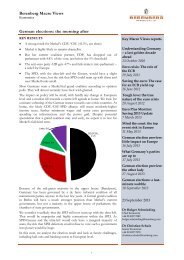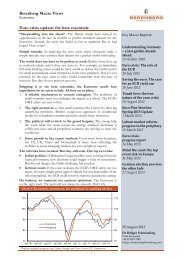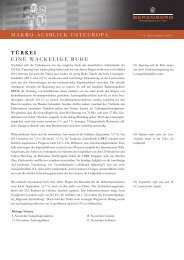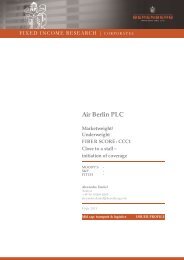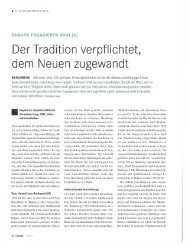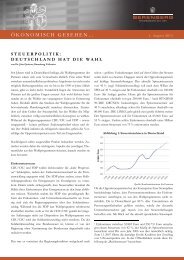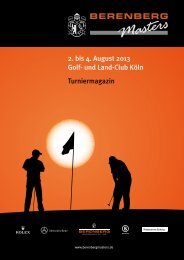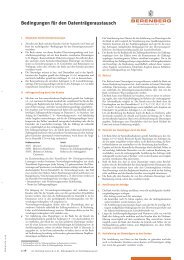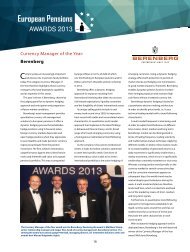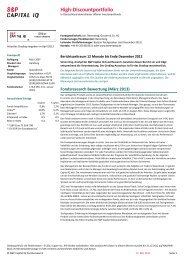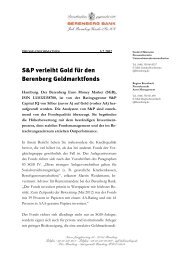Semiconductor Equipment - Berenberg Bank
Semiconductor Equipment - Berenberg Bank
Semiconductor Equipment - Berenberg Bank
Create successful ePaper yourself
Turn your PDF publications into a flip-book with our unique Google optimized e-Paper software.
<strong>Semiconductor</strong> <strong>Equipment</strong><br />
Technology Hardware<br />
Key debates<br />
Will the semiconductor space remain as cyclical as before?<br />
We believe the semiconductor cycle is going to remain cyclical, but less<br />
volatile compared to history. Over the past decade, we have seen cycle peaks in<br />
2000, 2007 and 2011, followed by a capacity digestion period, ie trough cycles in<br />
2002 and 2009, driven by different market trends. Memory was the main driver for<br />
the 2000 and 2008 cycle peak, and logic/foundry drove the peak cycle with<br />
memory in 2011.<br />
Figure 4: <strong>Semiconductor</strong> capex to remain flattish for the next two years<br />
USD mn<br />
80,000<br />
70,000<br />
60,000<br />
50,000<br />
40,000<br />
30,000<br />
20,000<br />
10,000<br />
-<br />
35%<br />
30%<br />
25%<br />
20%<br />
15%<br />
10%<br />
5%<br />
0%<br />
Semi capex $mn Semi equipment revenue $mn Semi capex/semi revenue %<br />
Source: Gartner data, <strong>Berenberg</strong> estimates<br />
The 2000 cycle was driven by 1) strong PC demand, 2) increased DRAM content<br />
per PC, 3) increased capacity for 0.13 micron, 0.18 micron and 300mm.<br />
In 2007, the cycle was driven by 1) Apple’s Nano/Shuffle products and other<br />
portable media players, which led NAND demand, 2) a DRAM demand increase<br />
due to increased adoption of 64-bit processors, Microsoft Vista and the Sony<br />
PlayStation 3 (PS3) launch, 3) an increased mobile phone DRAM demand, and 4)<br />
DRAM, Logic and NAND moving to smaller nodes.<br />
The 2011 cycle was influenced by 1) smartphone/tablet demand offset by PC<br />
demand, 2) leading-edge chip increases (logic: 28nm; NAND: 20nm; DRAM:<br />
30nm) as the consumer electronics market grew.<br />
We believe future cycles will be less volatile: In the future, we believe the<br />
semiconductor capex trend will be less cyclical compared to previous cycles for the<br />
following reasons.<br />
1) Memory-makers become more conservative in their spending: The<br />
previous three peak cycles were driven by memory. Memory-makers have<br />
tended to double their capex in the peak years (ie 2000, 2004-2007, 2010) and<br />
cut capex by half in the following one/two years. Following the 2012 memory<br />
price slump, memory-makers became more cautious and are now ramping up<br />
addition capacity slower than before. Therefore we believe the cycle volatility<br />
caused by memory spending will be significantly reduced.<br />
2) Foundry/logic spending is likely to remain strong: Intel, Samsung<br />
(excluding memory) and Taiwan <strong>Semiconductor</strong> Manufacturing Company<br />
(TSMC) (which together account for 78% total foundry/logic capex) are<br />
heavily exposed to the consumer electronic markets, and the competition in<br />
the market is further intensified by the war between Apple, Samsung,<br />
Qualcomm, Intel and ARM. We believe that these companies have no choice<br />
7


